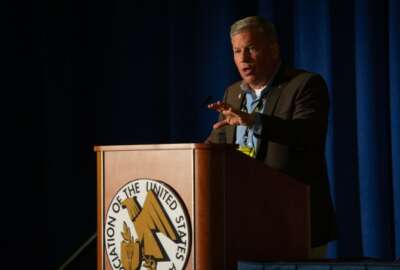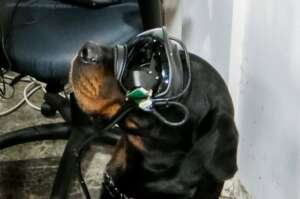
Army’s push for augmented reality goggles might extend to dogs, too
The Army Research Office is working on augmented reality goggles, radio communications for dogs who are already trained to sniff out explosives and landmines.
The DoD Reporter’s Notebook is a weekly summary of personnel, acquisition, technology and management stories that may have fallen below your radar during the past week, but are nonetheless important. It’s compiled and published each Monday by Federal News Network DoD reporters Jared Serbu and Scott Maucione.
Army fits canines with future technologies

The military is making big investments in things like augmented reality for training, but those investments aren’t only for humans.
The Army Research Office is working on augmented reality goggles for dogs that are trained to sniff out explosives and landmines.
The hope is that the goggles will help the canines with commands to inspect specific objects without putting their handler in danger.
“Getting dogs to do very specific things, to look at them or sniff them or to go through a specific door sometimes can be complicated with verbal commands, because they’re rather nonspecific,” said Stephen Lee, an ARO senior scientist. “What we decided was let’s put a feeler out for augmented reality goggles for military working dogs. Dogs have started wearing a lot of the rec specs goggles. Can we take and put ideas like Google Glass or whatnot into the goggles and guide the dog off leash around corners in buildings when we’re not there and also call the dog back?”
A.J. Peper answered the call when he started the company Command Sight. He trained his dog to respond to a laser pointer and then outfitted the dog with goggles. The goggles project a laser dot that is controlled by a smartphone.
“We are still in the beginning research stages of applying this technology to dogs, but the results from our initial research are extremely promising,” Peper said. “Much of the research to date has been conducted with my Rottweiler, Mater. His ability to generalize from other training to working through the AR goggles has been incredible. We still have a way to go from a basic science and development perspective before it will be ready for the wear and tear our military dogs will place on the units.”
The dogs are also outfitted with headphones and cameras so they can hear commands and handlers can see what the dog sees.
“What’s very interesting if you look at the canine and how it perceives the world, it’s very differently from us and it’s heavily reliant on the human handler because the dog can’t see the horizon,” Lee said. “If you have a dog in three feet of grass, the dog sees grass, it can’t see above the grass, but yet you can so it’s often responding to your commands.”
That’s how the Army hopes the goggles will work for dogs.
“If you really want the dog in a specific spot, maybe to look at that one backpack out of five backpacks, you can tell the dog to search and it might run around the room and search,” Lee said. “However, if you really want to get to that one backpack and rest on that and look at that, you need a visual cue. The laser pointer and the visual cue can actually get you to that point, which we again we couldn’t do otherwise if we’re not in the room with the dog. This augmented reality should provide that precision control.”
The research is currently in phase two of a Small Business Innovative Research contract. — SM
Senators want to broaden National Guard cybersecurity mission
A bipartisan duo of senators are trying to make the National Guard more available to states and local government to bolster cybersecurity for their critical infrastructure.
Governors can currently call up the Guard for certain missions; however, cybersecurity is limited to certain projects.
The bill introduced by Sens. Maggie Hassan (D-N.H.) and John Cornyn (R-Texas) would loosen those limitations and allow the Guard to protect the cyber assets of critical infrastructure as described by the 2001 Critical Infrastructures Protection Act.
“Cyber attacks can jeopardize our national security, shut down electrical grids, and threaten the operations of our hospitals and schools — we must ensure that the National Guard can help with these types of threats just like any other threat that states face,” said Hassan. “I’ve heard directly from Granite State leaders about how helpful our National Guard can be in increasing our cyber resiliency, and this bipartisan bill will make it easier for all states to fully use the impressive talents of National Guard members to help prevent cyberattacks before they happen.”
In the past the National Guard has provided cybersecurity assistance to states for election security, and also for state and local government networks that were hacked.
Some states have pilot Cyber Mission Assurance Teams. Their job is to assess vulnerabilities to infrastructure that supplies needs to federal assets.
“Ohio, Washington and Hawaii have teams,” former National Guard Bureau Chief Gen. Joseph Lengyel said last November. “What they do is they are able to check and mitigate cyber issues with federal installations that require assistance from critical infrastructure. A federal installation needs power and water to keep it running. This mission assurance team has been able to assess their vulnerabilities and perhaps come online and mitigate cyber attacks to assure that the federal mission of that installation can continue.” — SM
Financially struggling soldiers may see loans turn to grants
Soldiers who took out zero-interest loans with Army Emergency Relief to help make ends meet during the COVID-19 pandemic may have a nice end-of-year surprise.
The 78-year-old institution, which helps soldiers during financial struggles, is changing $1 million of its coronavirus-related loans to grants that do not need to be paid back.
“We’ve done a little over a million dollars in COVID support across the Army — about $300,000 of that was already a grant to begin with, another $700,000 of that approximately was in the form of a loan,” said Raymond Mason, AER directors. “What we do is we go back afterwards and review the case. We’re in the process of converting the vast majority of those loans into grants. We’ll let them know, ‘Hey, you don’t have to pay off the rest of this loan, we’re going to make it a grant, which of course is well received.’ The whole idea is look, families, soldiers, they’re struggling with COVID. And even though it’s a zero interest loan, we don’t want to add to their challenges and their financial hardship.”
AER is currently in a financially sound place where it doesn’t need to take in extra donations or draw deeper into investments in order to provide the grants. Part of that is because some corporate sponsors donated to AER to help with the pandemic.
In addition to the pandemic loans, AER is working on transitioning another million dollars of loans to grants, those were given to soldiers who needed emergency travel funds during hurricanes, wildfires and other natural disasters.
Mason said a lot of the pandemic loans went to military families where spouses lost their jobs.
“Families built their lifestyle and their monthly budget around those two incomes,” he said. “All of a sudden a lot of spouses were either laid off or the company went under during COVID. I would say the vast majority of the need we’ve seen has been for loss of spouse pay.”
Military spouses were already facing a 24% unemployment rate before the pandemic. About 17% of spouses reported losing their jobs as a result of the economic fallout, according to a new survey by Blue Star Families.
Mason said a lot of the loans went to E-5 and E-6 soldiers because those service members are moving off bases and have children and therefore have more bills to pay.
Surprisingly, AER has had less requests for loans than usual. In the spring, AER was loaning about a million dollars a month. It is now back up to its normal numbers of about $5 million a month.
AER loans about $70 million a year.
Mason said he thinks the dip in loan requests was due to soldiers being reluctant to ask for help.
“It does concern me, soldiers are taught from day one, ‘You’re tough, you can stand on your own two feet, you can make it and all that’s true,” Mason said. “But it builds a little bit of an issue of ‘I don’t want to ask for help.’ And I always say, asking for help is a sign of strength.”
Mason said some soldiers fear asking for help will affect their career, he said that is simply not true. — SM
Copyright © 2025 Federal News Network. All rights reserved. This website is not intended for users located within the European Economic Area.
Scott Maucione is a defense reporter for Federal News Network and reports on human capital, workforce and the Defense Department at-large.
Follow @smaucioneWFED





